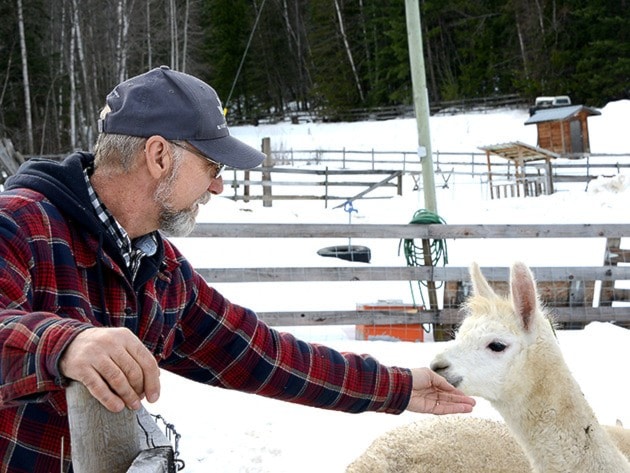A local couple that has been through a trying time is slowly recovering with the help of each other, family, friends, their religious faith and ... alpacas.
Stu Seib was the sergeant in charge of Clearwater RCMP detachment from 2003 until 2011. In November 2011 he was promoted to staff sergeant in charge of the Merritt detachment.
In an attempt to deal with the many high stress situations (very disturbing and violent scenes) that he had witnessed over his years of service, he began self-medicating with a controlled substance.
Realizing his helplessness and due to his strong personal beliefs, in January, 2012, he chose to turn himself in.
Following an investigation that made headlines across Canada, he was charged with stealing cocaine from the evidence locker in Merritt.
Eighteen months later he pled guilty to “breach of trust.” He was handed a conditional discharge, 50 hours of community service, plus one year probation. He also resigned from the RCMP.
He was able to get a pension, but it was less than what he would have received if he had continued on his career path.
“What do you do if you’re all of a sudden in retirement?” he asked. “We were both too young to do nothing.”
He and his wife, Bobbi, decided to stay on in the house they were building southeast of Clearwater.
They investigated various items they could produce and sell from the acreage they own.
One item they looked at was birch syrup. They travelled to a farm near Quesnel that produces it commercially.
The farm also raises alpacas and they noticed some alpaca blankets for sale.
They were amazed by how soft and warm the wool was.
On their way home they spotted some alpacas by Highway 24 near Bridge Lake.
They stopped to take some photos and the man from the house started shouting and waving at them.
They thought he was angry about them taking photographs but, in fact, he wanted to show them a newborn alpaca.
That was enough to convince them to buy six of the animals from a woman near 100 Mile House.
Two years later they bought eight more from the same lady.
Those purchases plus a couple of births (and one death) mean they now have a herd of 17.
“They’re a very peaceful animal,” said Bobbi Seib. “Generally speaking, the only noise they make is a low hum when they are contented.”
A couple of guard dogs live with the herd but one time when they might have been needed, the dogs were nowhere to be seen.
A bear got into the pasture with the alpacas. The mothers gave an alarm call, herded the young ones together, then formed a line between them and the bear.
Two of the bigger alpacas advanced on the bear, stamping their feet, making short charges, and looking fierce.
After a while the bear decided he had seen enough. He jumped over the fence and went back into the forest.
Alpacas are sheered once a year in June.
They don’t like the process but they do like it when it’s over.
The animals need to be strapped down when they are sheared. The work is done by a travelling professional.
“After it is done, they just go crazy. They dance around for hours. It must feel good to get rid of that heavy fleece,” said Bobbi Seib.
Alpaca fleece is 5-10 inches in length and differs from the typical sheep’s wool. It is several times warmer for its weight, and there is no lanolin.
 It is hypoallergenic, which is good for the people who react to the itch in sheep wool. Although not fire-proof, it is fire-resistant.
It is hypoallergenic, which is good for the people who react to the itch in sheep wool. Although not fire-proof, it is fire-resistant.
The best fleece (firsts) comes from the alpaca’s saddle area which is called the blanket.
The seconds and thirds come from the rest of the animal.
The fleece is separated by grade and also by color (there are 52 recognized natural alpaca colors).
Preparing the fleece is an involved process that includes hand-picking, carding and washing.
Washing needs to be done carefully to avoid felting – having the fibres bond together uncontrollably.
Felting can be done in a controlled manner, however, and the Seibs are investigating getting a machine that will do it for them (felting by hand can be extremely labor-intensive).
Alpacas come from the Andes region of South America and are well adapted to living in the mountains.
They have a three-sided shelter to protect them from the most extreme weather but usually they sleep in the snow.
The animals have an 11-month gestation period and typically will birth themselves.
“You’ll go out in the morning to feed and there will be a new baby cria,” said Stu.
The babies can stand up almost immediately, and are running about within four hours.
Seven alpacas will eat as much hay as one horse, meaning they are cheap to keep over the winter.
The herd all uses the same spot to go to the bathroom, and their droppings make good fertilizer.
The alpacas are still more of a hobby than a business, but the Seibs look forward to eventually selling enough fleece and handicrafts to make having them economically worthwhile.
In the meantime, they just take things day by day. Stu is looking at holding retreats at their home for police officers who find themselves in situations similar to the one he was in.
He hopes to show them that, no matter how difficult it might appear, it is possible to survive and overcome.
Below: Bobbi and Stu Seib get together with one of their guard dogs and some of their alpacas. She comes from a farming background while he does not - although his father used to shear angora goats and his mother used to spin.

